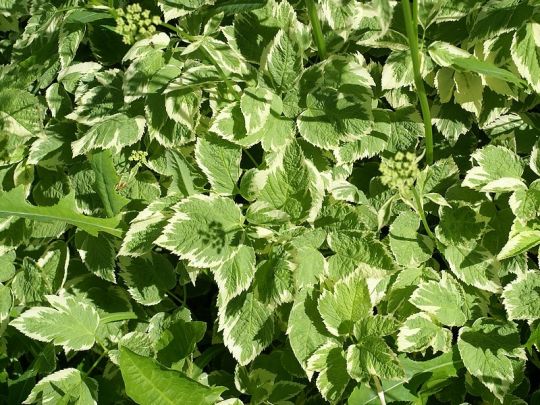
Goutweed
(Aegopodium podagraria)
Description
This invasive groundcover was originally brought into Canada as an ornamental garden plant but quickly spread out of control. Goutweed will often take over areas and starve native species of sunlight. It is native to Europe and Asia and came to North America in the mid-1800s. This low ground cover has groupings of three leaves with white and green coloration and serrated leaf edges.
-People intentionally plant it but also it can spread via yard waste.
-Removal is quite difficult but digging the plant with a shovel and covering an area with a tarp should kill it off
Range
Its found in most of southern Ontario and in large areas of mid-Ontario.
Impacts & Control
-Prevents native species from growing due to its dense coverage.
-Being low to the ground and blocking the sun, this plant allows little to grow near it
The eradication of Goutweed is extremely difficult as even the smallest root fragment can grow an entirely new plant. You will often see people with tarps covering large parts of their gardens/yards and this is one method to eliminate the plant. However, this method is unsightly and takes months to completely kill off the weed. After being deprived of sunlight for months, the plant and its roots will die off. Small patches can be manually removed but careful consideration must be made to remove every piece of root in order to prevent regrowth.

Garlic Mustard
(Alliaria petiolata)
Description
This herb was bought to America in the early 1800s to be used in cooking. However, it has spread rapidly, in a 4 year period the plant can double in its size overtaking forest regions. A way to identify it is in early spring when the shoots are coming up, when picked and crushed, they will release a pungent garlic aroma.
This invasive is particularly difficult as it can produce 60 000 seeds per square meter and the seeds can remain dormant for 30 years in the soil.
The young plants have dark green leaves which grow in a circular arrangement of leaves. The older plants can grow up to a meter high and have white flowering tops. The leaves on the older plants are triangular in shape and have sharp teeth on the leaves.
Range
It is common in south and east Ontario but it can be found as north as Sudbury.
Control & Impacts
This species is a high risk due to its impacts on our native species, such as trilliums, false rue anemone, American ginseng, hoary mountain mint, white wood aster, wild hyacinth and wood poppy.
As a landowner, the best way to combat garlic mustard is to look around your property in early spring and pull out any young plants. This hand removal method can be quite tedious but it is most effective to remove the shoots before they reach maturity.




